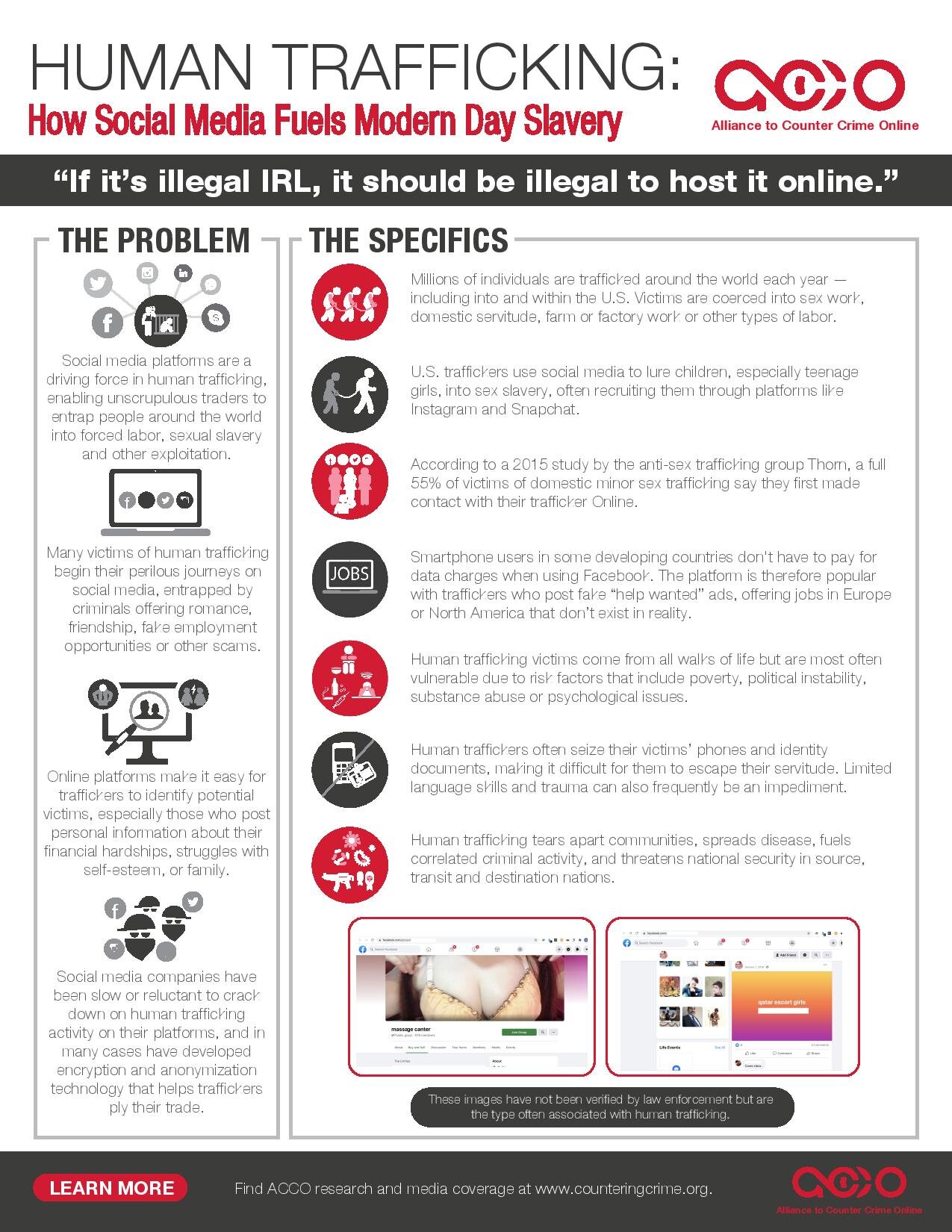Human Trafficking: How Social Media Fuels Modern Day Slavery
The Problem
Social media platforms are a driving force in human trafficking, enabling unscrupulous traders to entrap people around the world into forced labor, sexual slavery and other exploitation.
Many victims of human trafficking begin their perilous journeys on social media, entrapped by criminals offering romance, friendship, fake employment opportunities or other scams.
Online platforms make it easy for traffickers to identify potential victims, especially those who post personal information about their financial hardships, struggles with self-esteem, or family.
Social media companies have been slow or reluctant to crack down on human trafficking activity on their platforms, and in many cases have developed encryption and anonymization technology that helps traffickers ply their trade.
The Specifics
Millions of individuals are trafficked around the world each year including into and within the U.S. Victims are coerced into sex work, domestic servitude, farm or factory work or other types of labor.
U.S. traffickers use social media to lure children, especially teenage girls, into sex slavery, often recruiting them through platforms like Instagram and Snapchat.
According to a 2015 study by the anti-sex trafficking group Thorn, a full 55% of victims of domestic minor sex trafficking say they first made contact with their trafficker Online.
Smartphone users in some developing countries don't have to pay for data charges when using Facebook. The platform is therefore popular with traffickers who post fake “help wanted” ads, offering jobs in Europe or North America that don’t exist in reality.
Human trafficking victims come from all walks of life but are most often vulnerable due to risk factors that include poverty, political instability, substance abuse or psychological issues.
Human traffickers often seize their victims’ phones and identity documents, making it difficult for them to escape their servitude. Limited language skills and trauma can also frequently be an impediment.
Human trafficking tears apart communities, spreads disease, fuels correlated criminal activity, and threatens national security in source, transit and destination nations.
Key Facts and Figures
The shadowy nature of human trafficking makes it hard to quantify. The International Labor Organization (ILO) estimates that 25 million victims are trapped in modern day slavery.
Of these, 16 million are exploited for labor, nearly five million are sexually exploited, and more than four million are exploited in state-imposed forced labor.
Human trafficking is estimated to be a $150 billion business annually, making it the third largest global crime sector after drugs and guns.
The technology exists to identify human traffickers on social media. But few platforms deploy it, instead relying on users to report issues.
The FBI issued warnings in 2020 that social media and dating apps are used to entrap victims into slavery.
Human traffickers routinely advertise their victims online, using a blend of emojis and coded images to indicate that people are for sale.
Current Law
In 2000 the U.S. Congress passed the Trafficking Victims Protection Act (TVPA), a federal law aimed at tackling global sex and labor trafficking. The law has been reauthorized three times since its initial passage. In 2018 Congress passed The Stop Enabling Sex Traffickers Act (SESTA) and Allow States and Victims to Fight Online Sex Trafficking Act (FOSTA) package. This includes an amendment allowing for online marketplaces to face prosecution if they knowingly facilitate or benefit from sex trafficking.
Proposed Legal Reform
ACCO is pushing for global regulations that would give human trafficking victims a path to justice if they are trafficked by a criminal organization operating online. U.S. law should also be expanded and clarified to make it illegal for tech firms to host human trafficking content, regardless of whether the victim or perpetrator is in U.S. territory.
ACCO’s Mission
The Alliance to Counter Crime Online is a team of security experts, academics, NGO leaders, and citizen investigators who have come together to push organized crime and terror activity off Internet platforms.
Red Flags Indicating Potential Human Trafficking Risk
The following scenarios might be red flags for relationships or jobs that could develop into human trafficking. One or more of these may indicate that an individual is at-risk for sex or labor trafficking. This list is not exhaustive.
The Intimate Partner or Employer:
Comes on very strongly and promises things that seem too good to be true – i.e. proposes marriage quickly, or offers high wages for easy work.
Expects that you will agree to the employment or relationship on the spot, and threatens that otherwise the opportunity will be lost.
Is unclear about the terms of employment, location of employment and/or the company details/credentials.
Wants you to hand over your identity papers in order to get the job.
Can't provide a website or other information about the supposed place of employment, or an independent party who can confirm the job exists.
Displays signs/characteristics of a dangerous person including: attempts to control movement and behaviors, exhibits jealousy, lashes out or delivers punishment in response to noncompliance, is verbally/emotionally/physically abusive.
Uses threats or displays of violence to create a culture of fear.


